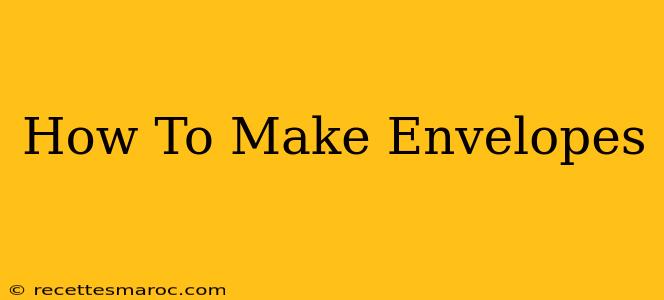Sending a handwritten letter or card is a thoughtful gesture that stands out in our increasingly digital world. But store-bought envelopes can be expensive, and sometimes you just need that perfect size for your project. Fortunately, making your own envelopes is easier than you think! This guide will walk you through various methods, from simple folds to more decorative techniques. Learn how to make envelopes at home and add a personal touch to your correspondence.
Method 1: The Classic Envelope Fold (Perfect for standard paper)
This is the simplest method, ideal for standard letter or A4 sized paper. You'll need:
- Paper: Letter-sized paper (8.5 x 11 inches) or similar works best. Thicker paper is preferred for sturdier envelopes.
- Ruler: For accurate measurements and clean folds.
- Scissors or Paper Cutter: For a neat finish.
- Glue Stick or Double-Sided Tape: To secure the flap.
Steps:
- Cut the Paper: If using standard letter-sized paper, cut a rectangle to your desired size. For a standard #10 envelope, cut it to 9 1/2 inches by 4 1/4 inches. Experiment with sizes to find what works best for your needs!
- Fold the Top: Fold the top edge down approximately 2.5 inches (or adjust based on your desired envelope size). This creates the flap. Crease the fold well.
- Fold the Sides: Fold in the two side edges to meet in the middle, aligning with the bottom edge. Crease well.
- Fold the Bottom: Fold the bottom edge up, tucking it into the flap created in step 2.
- Seal: Apply glue or tape to secure the bottom edges to the flap. Press firmly to ensure it adheres properly.
Tips for Success:
- Use a bone folder or similar tool to create crisp, clean folds for a professional look.
- For extra strength, use double-sided tape instead of a glue stick.
- Experiment with different paper weights and sizes for unique envelopes.
Method 2: The Easy Pocket Envelope (Great for smaller notes)
This method is perfect for making quick, smaller envelopes from scraps of pretty paper.
What you will need:
- Square or Rectangular Piece of Paper: The size determines the final envelope size.
- Scissors or Paper Cutter
- Glue Stick or Double-Sided Tape
Steps:
- Cut a square or rectangle: The size is completely up to you, experiment!
- Fold in Half: Fold the paper in half diagonally to form a triangle. Crease the fold well.
- Fold the Corners: Fold one corner of the triangle down to the bottom edge of the triangle, creating a smaller triangle. Repeat with the other corner.
- Fold Up the Bottom: Fold the bottom up to meet the two folded corners.
- Glue or Tape: Apply glue or tape to secure the bottom flap, creating a pocket for your message.
Tips for Success:
- Use decorative paper for a unique and attractive envelope.
- This method is great for using leftover scrapbook paper or other decorative materials.
Method 3: Decorative Envelope Making (Adding a personal touch)
Once you've mastered the basic folds, you can elevate your envelope game with decorative elements:
- Embellishments: Add stickers, washi tape, stamps, or other decorative elements to personalize your envelopes.
- Paper Choice: Use patterned paper, textured paper, or even fabric scraps to add visual interest.
- Hand-Drawn Designs: Get creative and draw or paint directly onto the envelope.
- Cutting Shapes: Use punches or stencils to create unique shapes or designs on the flaps.
Why Make Your Own Envelopes?
Beyond the cost savings, making your own envelopes offers several advantages:
- Personalization: Create unique, customized envelopes that perfectly match your message or style.
- Creativity: Explore different designs and techniques to express your creativity.
- Sustainability: Reduce waste by repurposing scrap paper or using eco-friendly materials.
Making your own envelopes is a rewarding and creative process. Start with the basic methods and gradually experiment with different techniques and decorative elements to create unique envelopes for your next correspondence. Happy crafting!

